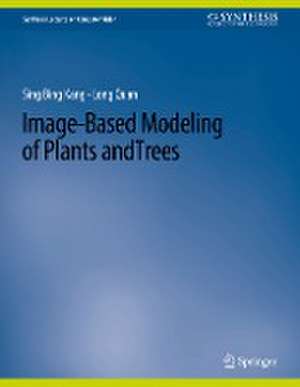Image-Based Modeling of Plants and Trees: Synthesis Lectures on Computer Vision
Autor Sing Bang Kang, Long Quanen Limba Engleză Paperback – 29 oct 2009
Din seria Synthesis Lectures on Computer Vision
- 20%
 Preț: 353.28 lei
Preț: 353.28 lei - 20%
 Preț: 254.49 lei
Preț: 254.49 lei - 20%
 Preț: 273.49 lei
Preț: 273.49 lei - 20%
 Preț: 273.49 lei
Preț: 273.49 lei - 20%
 Preț: 277.60 lei
Preț: 277.60 lei - 20%
 Preț: 224.50 lei
Preț: 224.50 lei - 20%
 Preț: 269.20 lei
Preț: 269.20 lei - 20%
 Preț: 224.00 lei
Preț: 224.00 lei - 20%
 Preț: 331.74 lei
Preț: 331.74 lei - 20%
 Preț: 225.67 lei
Preț: 225.67 lei - 20%
 Preț: 225.15 lei
Preț: 225.15 lei - 20%
 Preț: 352.78 lei
Preț: 352.78 lei - 20%
 Preț: 354.92 lei
Preț: 354.92 lei - 20%
 Preț: 297.49 lei
Preț: 297.49 lei - 20%
 Preț: 177.47 lei
Preț: 177.47 lei - 20%
 Preț: 356.73 lei
Preț: 356.73 lei - 20%
 Preț: 294.54 lei
Preț: 294.54 lei - 20%
 Preț: 415.95 lei
Preț: 415.95 lei - 20%
 Preț: 353.43 lei
Preț: 353.43 lei - 20%
 Preț: 329.76 lei
Preț: 329.76 lei - 20%
 Preț: 383.57 lei
Preț: 383.57 lei - 20%
 Preț: 329.26 lei
Preț: 329.26 lei - 20%
 Preț: 222.50 lei
Preț: 222.50 lei - 20%
 Preț: 358.04 lei
Preț: 358.04 lei - 20%
 Preț: 240.56 lei
Preț: 240.56 lei - 20%
 Preț: 331.37 lei
Preț: 331.37 lei
Preț: 147.75 lei
Preț vechi: 184.68 lei
-20% Nou
Puncte Express: 222
Preț estimativ în valută:
28.28€ • 29.41$ • 23.34£
28.28€ • 29.41$ • 23.34£
Carte tipărită la comandă
Livrare economică 09-15 aprilie
Preluare comenzi: 021 569.72.76
Specificații
ISBN-13: 9783031006807
ISBN-10: 3031006801
Ilustrații: X, 74 p.
Dimensiuni: 216 x 279 mm
Editura: Springer International Publishing
Colecția Springer
Seria Synthesis Lectures on Computer Vision
Locul publicării:Cham, Switzerland
ISBN-10: 3031006801
Ilustrații: X, 74 p.
Dimensiuni: 216 x 279 mm
Editura: Springer International Publishing
Colecția Springer
Seria Synthesis Lectures on Computer Vision
Locul publicării:Cham, Switzerland
Cuprins
Introduction.- Review of Plant and Tree Modeling Techniques.- Image-Based Technique for Modeling Plants.- Image-Based Technique for Modeling Trees.- Single Image Tree Modeling.- Summary and Concluding Remarks.- Acknowledgments.
Notă biografică
Sing Bing Kang received his Ph.D. in robotics from Carnegie Mellon University, Pittsburgh in 1994. He is Principal Researcher at Microsoft Corporation and adjunct faculty member of the School of Interactive Computing at Georgia Tech. His interests are image-based modeling as well as image and video enhancement. Sing Bing has co-edited two books in computer vision ("Panoramic Vision" and "Emerging Topics in Computer Vision"), and coauthored a book on image-based rendering. He has served as area chair and member of technical committee for the three major computer vision conferences, namely International Conference on Computer Vision (ICCV), IEEE Conference on Computer Vision and Pattern Recognition (CVPR), and European Conference on Computer Vision (ECCV). He was program co-chair for CVPR 2009, and has served as papers committee member for SIGGRAPH 2007, SIGGRAPH Asia 2008, and SIGGRAPH 2009. Sing Bing is currently an Associate Editor for IEEE TPAMI and Associate Editor-in-Chief for IPSJTransactions on Computer Vision and Applications. Moving back to Hong Kong in 2001, he has been a French CNRS senior research scientist at INRIA in Grenoble. His research interests are focused on 3D reconstruction, structure from motion, vision geometry, and image-based modeling. He has served as an Associate Editor of PAMI (IEEE Transactions on Pattern Analysis and Machine Intelligence) and as a Regional Editor of IVC (Image and Vision Computing Journal). He is currently on the editorial board of IJCV (the International Journal of Computer Vision), ELCVIA (the Electronic Letters on Computer Vision and Image Analysis), MVA (Machine Vision and Applications) and Foundations and Trends in Computer Graphics and Vision. He has served as area chair for ICCV (International Conference on Computer Vision), ECCV (European Conference on Computer Vision), and CVPR (IEEE Computer Vision and Pattern Recognition) and ICPR (IAPR International Conference on Pattern Recognition). He was a Program Chairof ICPR 2006 Computer Vision and Image Analysis, and is a General Chair of ICCV 2011 in Barcelona.
